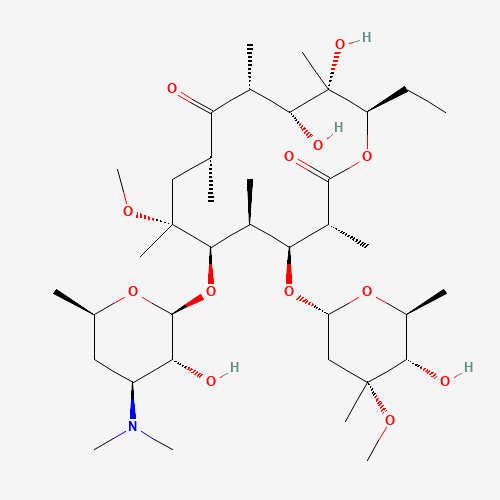| Pharmaceutical Information |
| Drug Name |
Clarithromycin |
| Drug ID |
BADD_D00480 |
| Description |
Clarithromycin, a semisynthetic macrolide antibiotic derived from erythromycin, inhibits bacterial protein synthesis by binding to the bacterial 50S ribosomal subunit. Binding inhibits peptidyl transferase activity and interferes with amino acid translocation during the translation and protein assembly process. Clarithromycin may be bacteriostatic or bactericidal depending on the organism and drug concentration. |
| Indications and Usage |
An alternative medication for the treatment of acute otitis media caused by H. influenzae, M. catarrhalis, or S. pneumoniae in patients with a history of type I penicillin hypersensitivity. Also for the treatment of pharyngitis and tonsillitis caused by susceptible Streptococcus pyogenes, as well as respiratory tract infections including acute maxillary sinusitis, acute bacterial exacerbations of chronic bronchitis, mild to moderate community-acquired pneuomia, Legionnaires' disease, and pertussis. Other indications include treatment of uncomplicated skin or skin structure infections, helicobacter pylori infection, duodenal ulcer disease, bartonella infections, early Lyme disease, and encephalitis caused by Toxoplasma gondii (in HIV infected patients in conjunction with pyrimethamine). Clarithromycin may also decrease the incidence of cryptosporidiosis, prevent the occurence of α-hemolytic (viridans group) streptococcal endocarditis, as well as serve as a primary prevention for Mycobacterium avium complex (MAC) bacteremia or disseminated infections (in adults, adolescents, and children with advanced HIV infection). |
| Marketing Status |
approved |
| ATC Code |
J01FA09 |
| DrugBank ID |
DB01211
|
| KEGG ID |
D00276
|
| MeSH ID |
D017291
|
| PubChem ID |
84029
|
| TTD Drug ID |
D0Z1ZM
|
| NDC Product Code |
49452-2112; 46708-344; 46708-345; 57237-044; 61919-643; 71335-1493; 0781-6023; 65096-0100; 53002-7561; 65862-226; 0527-1932; 76420-051; 27241-064; 43063-530; 68071-5045; 68788-8480; 0527-1930; 57237-045; 60687-435; 63187-376; 63187-625; 71335-1567; 38779-1937; 63415-0018; 43063-942; 53002-7562; 62332-345; 68788-7933; 0527-1931; 62991-2687; 51655-668; 65862-225; 0781-6022; 43666-0001; 60592-429; 50090-5285; 67296-1072; 67296-1360; 68071-3116; 70518-2773; 71335-0017; 72189-299; 0781-1961; 15894-0026; 27241-065; 62135-615; 62135-616; 62332-344; 0591-2805; 59566-0123; 50090-5282; 50268-178; 50268-179; 64380-906; 67296-0464; 68071-2869; 0781-1962; 43063-752; 43063-823; 64380-905; 68788-7125; 0904-6872; 43781-0403; 51552-1566; 50090-1830 |
| UNII |
H1250JIK0A
|
| Synonyms |
Clarithromycin | 6-O-Methylerythromycin | TE-031 | TE 031 | TE031 | A-56268 | A 56268 | A56268 | Biaxin |
|
| Chemical Information |
| Molecular Formula |
C38H69NO13 |
| CAS Registry Number |
81103-11-9 |
| SMILES |
CCC1C(C(C(C(=O)C(CC(C(C(C(C(C(=O)O1)C)OC2CC(C(C(O2)C)O)(C)OC)C)OC3C(C(CC(O3)C)N(
C)C)O)(C)OC)C)C)O)(C)O |
| Chemical Structure |

|
|
| ADRs Induced by Drug |
|
|
*The priority for ADR severity classification is based on FAERS assessment, followed by the most severe level in CTCAE rating. If neither is available, it will be displayed as 'Not available'.
**The 'Not Available' level is hidden by default and can be restored by clicking on the legend twice..
|
|
|

